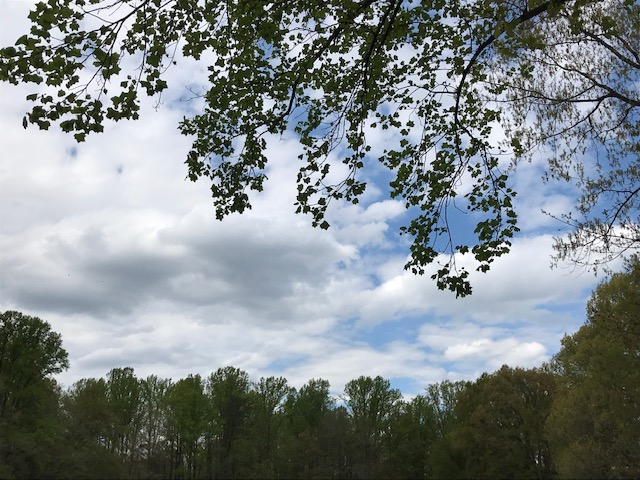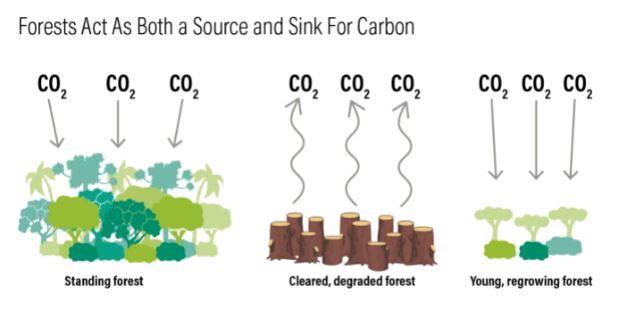
Are you working from home? Do you have a window in your home office? Can you view nature from your window while working? Do you have the luxury of taking a five-minute break from work to be near a houseplant? Or better, do you have a lunch break to stand or sit or lie down under a tree? In the world of Zoomtopia, we may need to spend more quality time with trees to reduce our technostress.
Last December, I wrote an essay titled “Biophilic Rhapsody.” Since then I’ve enjoyed shinrin-yoku (森林浴), forest bathing, whenever I can despite the COVID-19 restrictions. I’m blessed that I have a view of a big tree, which I once considered an eyesore, from the only window in my space of solitary confinement. A number of researches that are illustrated in Dr. Qing Li’s book titled Forest Bathing show a “green micro-break” can restore us when we are mentally fatigued; a brief glimpse of the color green before doing a creative task is enough to “enhance creative performance”; and a look at a picture of nature is enough to “improve cognitive performance.”
According to the World Health Organization, stress is the health epidemic of the 21st century. While high-paid professionals can receive stress-related counseling and therapy from their employer-sponsored health insurance, low-paid workers, many of whom are part-time contractors, are not that fortunate in coping with their job-related depression.
The right to health is central to the United Nations Sustainable Development Goals (SDGs), precisely SDG 3. And yet this human right is not widely achieved, not even in rich countries like the United States. Some say that the taxpayers will be burdened by those who cannot pay for their medical bills. If a society is composed of a large number of consumers who are either medically uninsured or are unable to access health care services, do you think the consumer market will be healthy, too? Working professionals become too sick to work, reducing productivity; lower income ensues. Low income slows the market. The pandemic year of 2020 was a testament to this phenomenon. Do you think the well-paid middle class can live safely alone when depressed fellow citizens turn grievances to violence? For the high-earning taxpayers, the price you need to pay is either to contribute more financially to a healthy medical care system for all or to suffer more unexpected societal insecurity and life-threatening risks. After all, when the poor make progress to enter a higher social class, they also need to pay their fair share to a healthy medical care system. Stress prevention relieves money stress and societal stress.
Technostress is part of the big family of stress. The word “technostress” was coined in 1984 to describe unhealthy behavior around new technology. The symptoms include checking your phone constantly, compulsively sharing updates and feeling that you need to be continually connected. Scientists warn that digital addiction increases loneliness, anxiety and depression. What’s worse, a growing number of scientific researches report that rising temperatures give rise to negative effects on mental health, including a potential higher rate of suicide. Have you been to the markets in a tropical country? If you have, you’d notice local vendors speak louder than their counterparts in colder countries. I’m not surprised to hear more people shouting at one another around the world as atmospheric temperature goes up and summer becomes longer. Global warming and forest loss conspire to create warmer, drier conditions, which in return render forests loss more vulnerable to fire and pest infestation. Subsequent burning and decay release more carbon emissions, feeding a vicious cycle.

Our health and the health of the forest go hand in hand. We can’t have a healthy population without healthy forests. Forests absorb twice as much carbon as they emit each year, providing a “carbon sink” that is 1.5 times more carbon than the U.S. emits annually. However, from the Amazon rainforest to the Congo rainforest, we’re losing forest at a rapid speed. Each year, more than 32 million acres of forest are lost across the world. That is an area around the size of England. Among the ten golden rules for restoring forests published by the UK’s Royal Botanic Gardens, Kew, this January, working with local people is Rule number two. This is a win-win solution for the underserved communities and the indigenous peoples around the world.
When indigenous peoples are present in forests and their rights are strengthened, forest cover is maintained. I remember the well-told story about the Lewis and Clark Expedition in which indigenous knowledge, accumulated over generations through direct contact with the environment, had provided invaluable guidance to Lewis and Clark. I’m also in awe and wonder about the powerful efficacy of traditional Chinese medicine (TCM). TCM is strictly based on the practicing experience of medical professionals dated back at least 2,200 years and does not depend on scientific evidence developed in Western medical labs. The ancient human knowledge dates back long before the first, second and third Industrial Revolution and the big data era with Amazon and Google.
The depth of shamans’ knowledge on preventive medicine and diagnostics is as fascinating as the social adaptive capacity of the indigenous peoples to adjust to or prepare for changes. If the year of 2021 is the Year of Healing, perhaps we should listen more to these native healers whose livelihoods are threatened as a result of their loss of habitat (Learn more click source 1 and source 2). During the Edo period in Japan, the ruling samurai class protected the trees that grew in the Kiso Valley (木曽路). They were only to be cut for the houses and temples of the powerful families. The violators would be punished—if you cut down a tree, your head would be cut off. In the Indian mangrove forest called the Sundarbans, locals worship Bonbibi, a forest goddess. They make vow to the goddess to take no more than they need from the jungle. If humans don’t respect and protect forests, who will?
If human activities have crossed the boundaries into the environment and virtual space, shouldn’t laws, regulations and standardization be expanded to these domains where human activities set foot?
In children’s books we often see trees, plants and animals talk to humans. If they can talk to humans, we’re suppose to protect them and value them as members of the planet. Perhaps in my own fantasy, children can be better leaders and be more accountable than adults to protect the existential relationships between humans and non-humans. Mother Nature has many sounds. If you want to feel the healing power of trees, disconnect yourself with your electronic devices and connect with a tree. Give yourself a treat to listen to the 100 soundscapes of Japan, for example. Or read more about how to live more respectfully with plants. Natural silence has been called one of the most endangered resources on the planet. Trees and shrubs are a cost-effective noise barrier. Why not become a tree hugger to let the music of nature rescue and restore our humanity?
